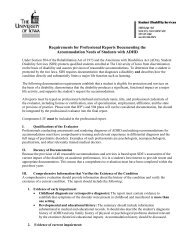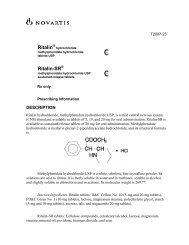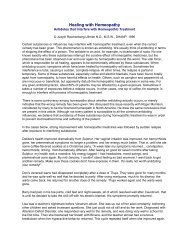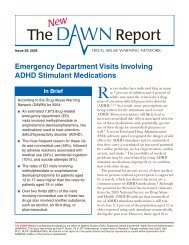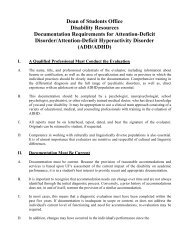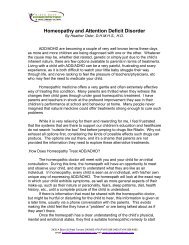Employees with Attention Deficit-Hyperactivity ... - ADHD Info Centre
Employees with Attention Deficit-Hyperactivity ... - ADHD Info Centre
Employees with Attention Deficit-Hyperactivity ... - ADHD Info Centre
- No tags were found...
You also want an ePaper? Increase the reach of your titles
YUMPU automatically turns print PDFs into web optimized ePapers that Google loves.
How is AD/HD treated<br />
Many adults are prescribed the same medications as children <strong>with</strong> AD/HD. Examples of<br />
medication include stimulant medications such as Strattera, and antidepressants such<br />
as Effexor and Wellbutrin (NIMH, 2003).<br />
Most experts agree that treatment for <strong>ADHD</strong> not be limited solely to the use of<br />
medications (NINDS, 2006). Treatment can include behavioral therapy, which can<br />
address time management, self-discipline, goal-setting, and decision-making (NINDS,<br />
2006).<br />
AD/HD and the Americans <strong>with</strong> Disabilities Act<br />
Is AD/HD a disability under the ADA<br />
The ADA does not contain a list of medical conditions that constitute disabilities.<br />
Instead, the ADA has a general definition of disability that each person must meet<br />
(EEOC, 1992). Therefore, some people <strong>with</strong> AD/HD will have a disability under the ADA<br />
and some will not. A person has a disability if he/she has a physical or mental<br />
impairment that substantially limits one or more major life activities, a record of such an<br />
impairment, or is regarded as having such an impairment (EEOC, 1992). To be a<br />
disability covered by the ADA, the impairment must substantially limit one or more major<br />
life activities. These are activities that an average person can perform <strong>with</strong> little or no<br />
difficulty. Examples are: walking, seeing, speaking, hearing, breathing, learning,<br />
performing manual tasks, caring for oneself, and working. These are examples only.<br />
Other activities such as sitting, standing, lifting, or reading are also major life activities<br />
(EEOC, 1992).<br />
Most courts have agreed <strong>with</strong> the activities listed by the EEOC. For example, in Brown<br />
v. Cox Medical Centers, 286 F.3d 1040 (8 th Cir. 2002), the Court noted that the “ability<br />
to perform cognitive functions” is a major life activity. In Gagliardo v. Connaught<br />
Laboratories, Inc., 311 F.3d 565 (3d Cir. 2002), the court held that “concentrating and<br />
remembering (more generally, cognitive function)” are major life activities (Fram, 2004).<br />
For more information about how to determine whether a person has a disability under<br />
the ADA, visit http://www.jan.wvu.edu/corner/vol02iss04.htm.<br />
4



